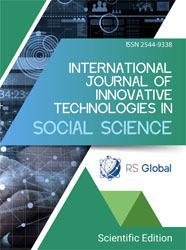INTEGRATION OF GIS AND MULTI-CRITERIA HIERARCHICAL ANALYSIS FOR URBAN PLANNING SUPPORT: CASE OF THE WILAYA OF CONSTANTINE
Abstract
Sustainable urban planning requires effective decision-making tools, especially in contexts of rapid development and increasing environmental pressures, as is the case in the wilaya of Constantine, Algeria. Integrating Geographic Information Systems (GIS) with Analytical Hierarchy Process (AHP) offers a robust methodology to support this decision-making process. This approach has proven useful in interpreting complex spatial issues. By identifying criteria aligned with targeted objectives and mapping geographic and attribute data at the Constantine wilaya scale, it was possible to prioritize identified indicators, quantitatively assess the phenomenon, and compare various development scenarios within the study areas. The study results indicated that, of the total area of 221,819 km², 55.17% (122,382 km²) of barren lands (suitable for habitability) are most suitable for urban development, 26.84% (59,550 km²) are moderately suitable for urban development, 10.56% (23,430 km²) of agricultural areas (non-buildable) are least suitable for urban development, 1.66% (12,771 km²) are forests (non-buildable), and 5.75% (3,686 km²) of these lands are considered unsuitable for urban development (perennial areas, non-buildable) but rather designated for agricultural use or strategic reserves hosting economic or tourist activity areas.
This combination allows for handling complex spatial information and systematically evaluating various criteria, thus promoting optimal urban planning. Additionally, the process enabled visualization on maps of the area’s most suitable for urbanization and provided valuable insights to specialists for land use choices, including areas to develop, preserve, or protect.
References
ANDRE, P., DESLISLE, C., REVERET, J-P. (2003): L’évaluation des impacts sur l’environnement : processus, acteurs et pratiques pour un développement durable, Presses internationales Polytechnique; 519 p. https://publications.polymtl.ca/26137/.
ARCINIEGAS G., JANSSEN R. et OMTZIGT N. (2011): Map-based multicriteria analysis to support interactive land use allocation, International Journal of Geographical Information Science, 25:12, 1931-1947. https://core.ac.uk/download/pdf/15472898.pdf
Benidir F,(2007) Urbanisme et planification urbain. Le cas de Constantine, thèse de doctorat en Urbanisme, sous la direction de Guy Burgel, Université Mentouri Constantine, 2007, p. 20. https://thesesalgerie.com/1485988427345019/these-de-doctorat/universite-freres-mentouri-constantine-1/urbanisme-etplanification-urbaine
Bendjaballah Boudemagh O, « Politiques urbaines, terres agricoles et marché foncier : quel avenir pour l’agriculture périurbaine à Constantine (Algérie) ? », Cahiers Agriculture, no 22, 2013, p. 549. https://doi.org/10.4000/cdlm.14214
Bekhetari mohamed cherif ,2015. Les méthodes multi-critères pour analyser les aptitudes des terres agricoles: le cas du blé tendre en Languedoc Rousillon analysé avec la méthode AHP. http://dx.doi.org/10.13140/RG.2.1.2184.7122/1
FEIZIZADEH B. et BLASCHKE T. (2012): Land suitability analysis for Tabriz County, Iran: a multi-criteria evaluation approach using GIS, Journal of Environmental Planning and Management, pp1-23. http://dx.doi.org/10.1080/09640568.2011.646964
Habes S.,(2021), SIG et méthode AHP pour la prévision en planification urbaine « Analyse de l'adéquation des sites pour le développement urbain. Université Larbi Tebessi –Tébessa.Master en Informatique. http://dspace.univtebessa.dz:8080/jspui/bitstream/123456789/790/1/methode-AHP-et-SIG-pour-la-prevision-en-planificationurbaine.pdf.
Kehal .K.(2006), Le lotissement résidentiel : enjeux urbanistiques et développement urbain durable: Cas de Constantine (entre recherche de la qualité urbanistique et la consommation du foncier), Magistère en urbanisme, sous la direction de Djamila Rouag, Université Mentouri Constantine,.
LAARIBI, A. (2000): SIG et analyse multicritère, Paris : Hermès Science Publications, 196p. https://doi.org/10.7202/007968ar
LE GALL, AC. (2009): Panorama des méthodes d’analyse multicritère, INERIS, Paris. https://www.ineris.fr/sites/ineris.fr/files/contribution/Documents/le-gall-2009-drc-09-102861-12257a-mcdaaction-18a-1352824541.pdf
MAMMERI, ML. (2013): Une approche d’aide multicritère `a la décision pour l’évaluation du confort dans les trains: construction d’un modèle d’évaluation. Université Paris Dauphine - Paris IX. https://theses.hal.science/tel-00915734
Malczewski.j (1999), GIS and Multicriteria Decision Analysis, New York: John Wiley & Sons , 1999.
O.N.S. (2023). National Statistical Office, Algeria https://www.ons.dz
Roy, B,. ( 1985). Méthodologie multicritère d’aide à la décision. Paris, France: Economica.
SAATY, T.L. (1977): A scaling method for priorities in hierarchical structures, Journal of Mathematical Psycology, N°15, pp. 234-281. https://www.sciencedirect.com/science/article/pii/0022249677900335
SAATY, T.L. (1980): The Analytic Hierarchy Process. McGraw-Hill, New York, USA. https://www.sciencedirect.com/science/article/pii/0270025587904738.
SALOMON, V. A. P. (2001): A compilation of comparisons on the analytic hierarchy process and others multiple criteria decision making methods: some cases developed in Brazil, 6th ISAHP, 2-4 août 2001, Berne, Switzerland, p. 413-420. https://www.isahp.org/uploads/071-p.pdf
Sidi Mohamed El Amraoui Mohamed Rouchdi, Mourad Bouziani, Abdelwahed El Idrissi, Integration du Sig et de l’analyse hierarchique multicritere pour l’aide dans la planification urbaine : etude de cas de la province de Khemisset, Maroc. Journal Papeles de Geografía 2017, 63 pp. 71-90 DOI: http://dx.doi.org/10.6018/geografia/2017/280211. ISSN: 1989-4627.
URBACO, Rapport d’orientation du PDAU du groupement urbain de Constantine, 2016.
URBACO.Constantine., (2024). urbacirta@urbaco-dz.com
Views:
82
Downloads:
40
Copyright (c) 2024 Boussetti Sandra, Yahia Amina

This work is licensed under a Creative Commons Attribution 4.0 International License.
All articles are published in open-access and licensed under a Creative Commons Attribution 4.0 International License (CC BY 4.0). Hence, authors retain copyright to the content of the articles.
CC BY 4.0 License allows content to be copied, adapted, displayed, distributed, re-published or otherwise re-used for any purpose including for adaptation and commercial use provided the content is attributed.















